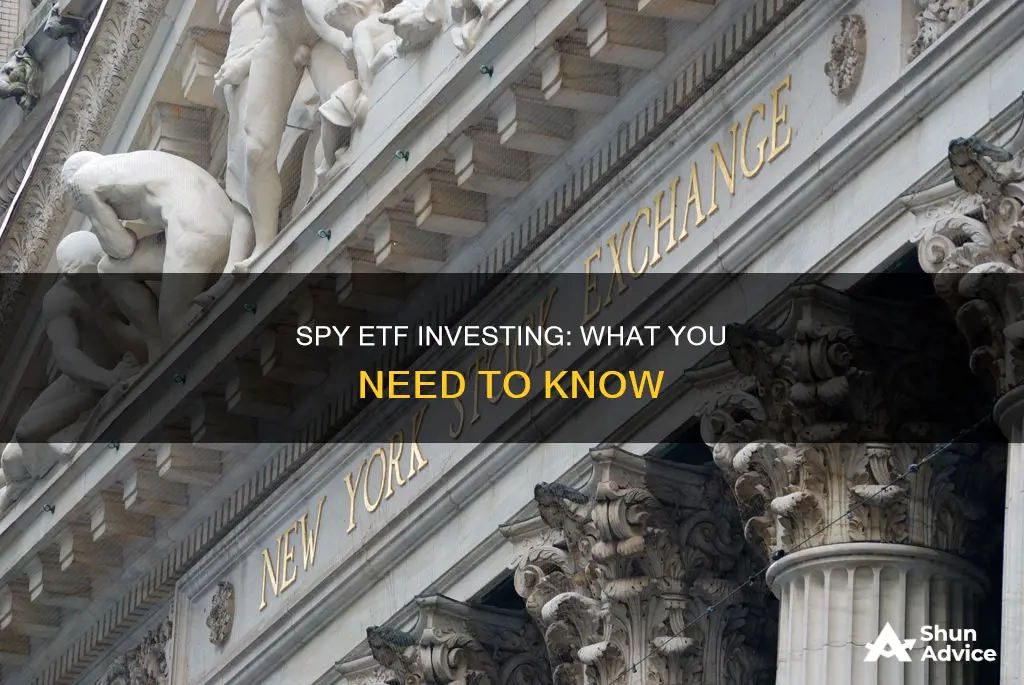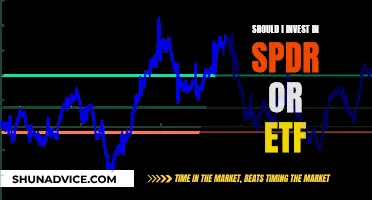
The SPDR S&P 500 ETF Trust, or SPY, is an exchange-traded fund (ETF) that tracks the performance of the S&P 500 index, a basket of the 500 largest publicly traded companies in the US. SPY was the first ETF listed on a US exchange when it debuted in 1993 and is still the largest ETF on the market today. SPY has generated an average annual return of over 9% since its inception and offers investors a cost-effective, diversified investment option.
| Characteristics | Values |
|---|---|
| Launch Date | 22nd January 1993 |
| Type | Exchange-Traded Fund (ETF) |
| Purpose | Track the performance of the S&P 500 index |
| Management | Passively managed |
| Number of Stocks | 500 |
| Top Sectors | Information Technology, Healthcare, Financials, Consumer Discretionary, Communication Services |
| Expense Ratio | 0.0945% |
| Assets Under Management (AUM) | $481.4 billion (as of early 2024) |
| Average Annual Return | 9%+ since inception |
| Dividend Yield | 1.23% (as of September 2024) |
| Dividend Payment Frequency | Quarterly |
| Listed | New York Stock Exchange (NYSE) |
What You'll Learn

SPY ETF's top holdings
SPY ETFs, or the SPDR S&P 500 ETF Trust, is an exchange-traded fund that tracks the performance of the S&P 500 index, which is a basket of the 500 largest publicly traded companies in the U.S. SPY ETFs are well-diversified, with holdings across multiple sectors, including information technology, consumer discretionary, and communication services.
As of September 25, 2024, the top holdings of the SPY ETF included stocks from the following companies:
- Alphabet Class A (GOOGL)
- Meta Platforms—Class A (META)
- Alphabet Class C (GOOG)
- Berkshire Hathaway Class B (BRK.B)
These top holdings are subject to change over time, and it is important for investors to stay up-to-date with the latest information. As of January 31, 2024, Berkshire Hathaway Inc. Cl B was also listed as a top holding.
The SPY ETF is constructed as a unit investment trust (UIT), which means it has a fixed portfolio that forms units that can be created and redeemed with the issuer. This structure allows the SPY ETF to fully replicate the S&P 500 Index, holding all members of the underlying index at their target weights.
By investing in the SPY ETF, investors gain exposure to a well-diversified basket of large-cap U.S. stocks, providing a convenient and low-cost way to invest in the S&P 500 index.
Ireland's Guide to ETF Investing: Getting Started
You may want to see also

SPY ETF's competitors
The SPDR S&P 500 ETF Trust, also known as the SPY ETF, is among the most popular exchange-traded funds (ETFs). It was the first index exchange-traded fund listed on U.S. exchanges when it launched in January 1993.
Since its inception, several other ETFs have emerged that track the S&P 500 Index, becoming competitors to the SPY ETF. When considering these competing ETFs, investors should evaluate the expense ratio, tracking error, and liquidity of each option. Here is a list of some of the competitors to the SPY ETF:
- Vanguard S&P 500 ETF (VOO): This ETF has a significantly lower expense ratio compared to SPY, at 0.03%.
- IShares Core S&P 500 ETF (IVV): The iShares Core S&P 500 ETF is another alternative with a low expense ratio of 0.03%.
- SPDR Portfolio S&P 500 Growth ETF (SPYG): This ETF focuses on growth stocks within the S&P 500 Index.
- Invesco S&P 500 Equal Weight ETF (RSP): The Invesco S&P 500 Equal Weight ETF is designed to provide equal weight to all 500 stocks in the index, rather than a cap-weighted approach.
- Schwab S&P 500 Index Fund (SWPPX): This fund is a mutual fund alternative to the SPY ETF, with a low expense ratio of 0.02%.
These competing ETFs offer investors alternative options to gain exposure to the S&P 500 Index, each with its own unique characteristics and fees. Investors should carefully consider their investment objectives, risk tolerance, and expenses associated with each ETF before making any investment decisions.
A Monthly Guide to ETF Investing
You may want to see also

Should you invest in the SPY ETF?
The SPDR S&P 500 ETF Trust, or SPY, is the oldest and largest exchange-traded fund (ETF) listed on a US exchange. It was launched in 1993 and has since grown to $481.4 billion in assets under management as of early 2024. The SPY ETF is designed to track the performance of the S&P 500 index, which is a basket of the 500 largest publicly traded companies in the US.
Advantages of Investing in the SPY ETF
The SPY ETF offers investors several advantages, including:
- Low expenses: With an expense ratio of 0.0945% to 0.095%, the SPY ETF is much cheaper than the average mutual fund, which often has expenses of 0.50% or more.
- Diversification: The SPY ETF provides investors with access to 500 of the largest publicly traded companies in the US across 11 different sectors, reducing market risk.
- Convenience: It enables investors to easily gain access to the stock market without having to research and analyse individual stocks or actively maintain a portfolio.
- Tax efficiency: ETFs have low turnover and trade like stocks on an exchange, passing very little tax on to shareholders.
Disadvantages of Investing in the SPY ETF
There are also some disadvantages and risks to consider before investing in the SPY ETF:
- Limited returns: As a passively managed fund, the SPY ETF can only produce returns that match the S&P 500 index, minus fees and expenses. Actively managed funds have the potential to outperform the market.
- Lack of diversification: The SPY ETF primarily invests in large-cap US funds, so shareholders are not exposed to other types of securities such as small-cap stocks, international stocks, or bonds.
- Market risk: As with any investment in the stock market, the SPY ETF is subject to market volatility and economic and geopolitical risks. The value of equity securities can fluctuate and may decline significantly due to individual company performance, market conditions, and economic factors.
Whether or not you should invest in the SPY ETF depends on your personal investment goals and risk tolerance. The SPY ETF is considered a diversified investment, but it consists entirely of stocks, which can be volatile and lead to price fluctuations and potential losses. However, the SPY ETF's low expenses, diversification across large US companies, and convenience make it a solid option for investors looking to gain exposure to the US stock market and diversify their portfolios.
XSP ETF: Exploring its Investment Strategies and Opportunities
You may want to see also

How to invest in the SPY ETF
The SPY ETF (also known as the SPDR S&P 500 ETF Trust) is an exchange-traded fund that tracks the performance of the S&P 500 index, which is a basket of the 500 largest publicly traded companies in the US. It is the oldest ETF listed on a US exchange and is one of the most popular and most-traded ETFs in the world.
- Open a brokerage account: You will need a brokerage account to invest money. You can open one online, as long as you are 18 or older. You will need to provide some personal information, such as your address, Social Security number, and date of birth. You will also need to choose the type of account you want. If you are investing money you may need before retirement, you could open a taxable brokerage account. If you are investing for the long term, consider buying the SPDR S&P 500 ETF Trust in an individual retirement account (IRA) to lock in a tax break.
- Figure out your budget: Decide how much you can afford to invest. Since the SPDR S&P 500 ETF is well-diversified, it is okay to put most of your investing budget into this ETF. However, you may not want to put all your money into the ETF at once. Many investors use a strategy called dollar-cost averaging, where they invest on a set schedule to take advantage of low prices.
- Do your research: Familiarize yourself with the investment prospectus and learn how the fund works, as well as the alternatives. While you don't need to scrutinize balance sheets and other financial statements, it is important to do your homework with any investment.
- Place your order: Once you have completed the first three steps, you can place your order. Enter the fund's ticker symbol, SPY, and indicate how many shares you want to buy (or the dollar amount you want to invest) and whether you are placing a market or limit order.
- Choose a broker: ETFs are traded like stocks and are bought and sold through brokerage accounts. If you don't already have one, you will need to open and fund a brokerage account before you can purchase SPY.
Remember to consider your financial situation, risk tolerance, time horizon, and preferences before investing in the SPY ETF or any other financial product.
ETFs: Smart Small Investments for Long-Term Financial Growth
You may want to see also

SPY ETF's risks
SPY ETFs are a type of exchange-traded fund (ETF) that tracks the performance of the S&P 500 index, which is a basket of 500 of the largest publicly traded companies in the US. SPY ETFs are a popular investment vehicle due to their low expenses, diversification benefits, convenience, and tax efficiency. However, there are several risks associated with investing in SPY ETFs that investors should be aware of:
Market Risk
SPY ETFs are subject to market risk, as they are investments in the stock market. The value of the ETF's shares can fluctuate with the performance of the underlying stocks in its portfolio. For example, if the stock market experiences a downturn, the value of the SPY ETF's shares may also decrease.
Inflation Risk
SPY ETFs may also face inflation risk, as the value of the fund's assets may be eroded by rising prices over time. Inflation can impact the purchasing power of the fund's assets and affect its overall value.
Credit Risk
Credit risk is another factor to consider when investing in SPY ETFs. If one or more of the companies in the ETF's portfolio experiences financial difficulties or goes bankrupt, it could result in a decline in the value of the ETF's shares. This is because the financial health of the underlying companies directly impacts the value of the ETF.
Liquidity Risk
While SPY ETFs are generally considered highly liquid investments due to their high trading volume, there is still a risk that it may be difficult to buy or sell shares of the ETF when desired. Market conditions or other factors could impact the liquidity of the ETF, making it challenging for investors to exit their positions.
Country Risk, Currency Risk, and Interest Rate Risk
As SPY ETFs track 500 large-cap US stocks, they are primarily exposed to the US market and currency. This means that investors in SPY ETFs are taking on country risk and currency risk. Additionally, changes in interest rates in the US can impact the performance of the underlying stocks in the ETF's portfolio, leading to interest rate risk.
In conclusion, while SPY ETFs offer a convenient and diversified way to gain exposure to the US stock market, investors should carefully consider these risks before making any investment decisions. It is crucial to assess your investment objectives, risk tolerance, and conduct thorough research before investing.
Alternative Harvest ETF: A Smart Investment Move?
You may want to see also
Frequently asked questions
The SPDR S&P 500 ETF Trust, listed on the New York Stock Exchange as SPY, is a popular exchange-traded fund (ETF) that tracks the performance of the S&P 500 index.
The SPY ETF is an index fund that aims to replicate the returns of the S&P 500 index by holding stocks in the same proportion as their weighting in the index.
The SPY ETF offers investors diversification, tax efficiency, low fees, and minimal maintenance. It provides exposure to a broad range of large-cap U.S. stocks in multiple sectors.
The SPY ETF is subject to market volatility and economic and geopolitical risks, which can lead to significant declines in value.
Investors can buy and sell shares of the SPY ETF through a brokerage account, a self-directed investment account (such as an IRA), or with the assistance of a broker or financial advisor.







